Published: November 13th, 2018 Last Modified: April 21st, 2019
Homemade phase lock gel, which we can generically call phase separating gel (PSG), can be a useful addition to your DNA extraction repertoire. The best part is that for many applications you can use 100% DOW High Vacuum grease, which makes it very economical. Unfortunately, for RNA extractions with TRIzol, the stock PSG is not dense enough to migrate between aqueous and organic phases, and simply settles on top of your aqueous phase. BOO!!!
Now, I’ve been trying to solve this problem for a while, but this is the first time I think it’s been successful. Basically, by combining vacuum grease with 15% w/w silicone dioxide (i.e. 20g grease + 3g SiO2), you end up with PSG dense enough to work properly with TRIzol. Lets take a look at how to do it with a minimum of mess!
So, vacuum grease with 15% w/w silicone dioxide you say? Sounds straightforward in principle, just mix the two together and off you go. Well, that’s only half the story. The other half is mixing your dense PSG well enough so that it migrates as a single entity during centrifugation AND not covering half your lab with silicone grease. Yeah, get that stuff on your pipette? Be prepared to have it pop out of your hand! So, first things first, lay down some lab mat and have a box of gloves at hand.
Now, how to mix the two together? Don’t try and heat it, vacuum grease is stable up to 200C by design, doesn’t help. Here’s how I first attempted this on a bulk scale:
So, about 20g of vacuum grease in a cheap, dollar store stainless bowl. Added 3g of SiO2 and used a cheap silicone spatula:
Mmmm….I love cookie dough. Anyway, spoiler alert, this got messy, I was doing pretty well until some got on the side of the bowl and it got away from me. So, that’s what NOT to do.
Instead, get a high quality ziplock bag (emphasis on the high quality) add your ingredients, zip it, and double bag it. Now, use your hands to mix the PSG together and gather it all in a corner. Cut the corner, and like a pastry bag dispense as much as you can get into a large syringe. This process is likely to be the messiest so watch out.
After you get your dense PSG into the large syringe, life is a bit easier and you can aliqout into smaller syringes for autoclaving. Best to do this in large batches so you don’t have to do it frequently!
So, got dense PSG? Don’t wanna pay 300$ a bottle for TRIzol? Well, I’ve been quite happy with the following TRIzol recipe, much cheaper than buying it if you go through a lot like our lab does (Source).
How well do these two homemade reagents work together? Quite well, it seems. For the following experiments I ground leaf tissue in liquid nitrogen and added 1 mL homemade trizol per 100 mg tissue, vortexed and let it sit at room temperature for maybe 20 minutes. Afterwords, I pelleted the lysate and transferred the supernatent to a tube that had ~1 mL of dense PSG at the bottom. Then, I added chloroform as per the Trizol manual, vortexed and centrifuged for 10 minutes at ~3.8k RCF (for 50 mL tubes, 16k RCF for 1.5 mL tubes).
So, you don’t need much dense PSG for the 1.5 mL, but the 50 mL tubes take at least 1 mL. You can see in some tubes I didn’t add enough and the organic phase starts poking through. Good thing we can make buckets of the stuff for cheap now, huh? 🙂






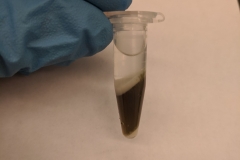
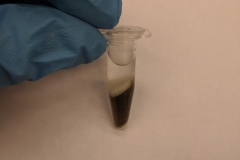
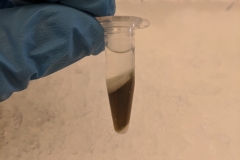
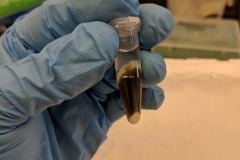

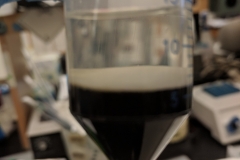
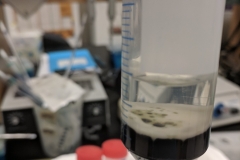
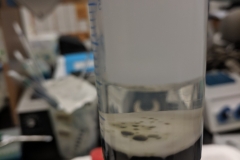
Thanks for your good idea.
Can i ask some details. You mention that you add SiO2 to give more density to sink .
But i know Si02 can absorb DNA or RNA in the presence of high guanidiunum. Just like your home brew plasmid recipe. Sio2 will absorb DNA, RNA in solutions. So is there possibility Sio2 absorb RNA/DNA, which result loss of RNA/DNA? Do you really extract RNA by Trizol and compare the yield
using Sio2 PLG or not using PLG.?
Second, it seems sticky and not liquid. how to aliquote PLG into 1.5ml tubes in bulk? Can you give tips to aliquote?
Thanks a lot.
Hey, glad you like it!
So, you are absolutely correct that there can be binding of RNA/DNA to the SiO2 under high Gu-HCL/TCN. However in this application the relative surface area of SiO2 presented to the buffer is low when compared against porous, 1-10 uM SiO2 used in kits. Once you mix the grease + SiO2, the resulting paste is very sticky and stays together, so your buffer never really mixes with it. Also, potential loss on the surface of the grease is likely offset by the fact that you can recover more of the aqueous phase without getting close to the organic. The original paper shows that it doesn’t seem to effect yield: https://academic.oup.com/nar/article-abstract/21/3/781/2386549?redirectedFrom=PDF
Now, the stickyness is what makes it a bit messy, so try and get your paste into 1-5 mL syringes as quickly as possible so that you can aliqout more easily. Usually I autoclave the grease directly in the syringes, but there could be better ways to do it. Then, squirt a little bit into the 1.5 mL tube and spin the tube at 16000g for 60s and the grease will end up as a pellet. Then, once you’ve added your organic/aqueous mix to the tube and vortexed, spin at 16000g for ~5 minutes to let the gel migrate between the phases.
When I used the dense PSG with homemade trizol, I obtained 500 ug of total RNA from 10g leaf tissue, which is what you’d expect.
Fantastic post! Nobel prize in lab DIY!
I was going to try this out following your previous post about the dense version but I never got around to it. Should I follow the instructions there for the SiO2 (which size and size fractionation)?
Also, thanks for the link of the trizol recipe and combining it with your gel!
Glad you enjoy it 🙂
So, the size fractionation is really more for making SiO2 slurry for plasmid/PCR/genomic DNA extractions. Ideally for dense PSG you would use the finest particle size you could get economically, but then the SiO2 wouldn’t be as good for DNA extractions. The 0.5-10 μm particle size seems to work well for both methods and for the PSG you can use it straight without fractionation.
Yeah, I’m quite happy I found that Trizol method too! I tried reverse engineering RNAzol/Qiazol from a patent a while back and it didn’t go great.
I really enjoyed reading this and the previous article on PSG. I am just wondering whether nanometer SiO2 or 0.5-10 μm SiO2 would be better for Trizol/Chloroform extraction of RNA? Maybe you have any suggestion?
Thank a lot on this great idea!!!
Glad you enjoyed the article! I think for the purpose of making dense PSG the smaller particles would mix better with the vacuum grease. The larger particles will separate out with prolonged centrifugation. Doesn’t affect how it works, its more of a visual appeal thing.
Clever idea. I wonder if using a product like Silly Putty would work as well. Like DOW vacuum grease it is made from PDMS, but it has additives that makes it a little heavier.
what is difference between trizol and trizol Ls composition ?
I believe Trizol LS is optimized towards liquid samples, which would suggest that it has a higher concentration of guanidinium isothiocyanate etc to offset the increase in overall volume.
Hi,
Nice work as always.
So do you keep two batches of the stuff? (10% from the previous post P/C extraction and 15% for trizol)
Regards,
I keep a main syringe full of the straight vacuum grease since that’s what I use the most, some of the 10% SiO2 for genomic type extractions, and 15% for the Trizol-esque extractions.
You probably don’t need to make all the variants, there will probably be just one assay your lab uses the dense stuff for.
This is extremely interesting and helpful, thanks for all your efforts working this and related PSG methods out. I have a question about a potential alternative to DIY heavy PSG – what about just adding sterile ddH2O to reduce the salt concentration and density of the aqueous phase? I just did a few tests with this and using tissue homogenized in 1.4M/NaCl 100mM Tris/30mM EDTA/2% CTAB buffer I had to add about 50% v/v ddH2O before the vacuum grease moved from the top layer to the interphase. I think this should be okay, because the high salt concentration has already done its work during the grinding and water bath incubation steps. I’ve taken the process to completion just now and see a visible white pellet after isopropanol precipitation. Do you think this would be a viable alternative to modulating the density of the PSG?
I was wondering if you’ve tried with the fine 20 nm silica particles yet. I did: I bought some from what seemed to be a reputable vendor on Amazon (I mention this only to say that I was too cheap to try the Sigma version for a first outing, and maybe buyer beware), and mixed it as you described with Dow high vacuum grease, but ran into some problems right away. Mainly, the viscosity was insanely high – like wax just before it hardens. I was able to mix it in the bag, but it was too viscous to squeeze out. I had to use a disposable spatula to scrape it out into a 10 ml syringe, but then it was almost impossible to push out into smaller syringes. Using all my might, I would guess that the flow rate was < 100 ul/sec – i.e. pushing the plunger as hard as I could, I could squeeze out less than 1 ml in 10 sec. And with that much force, the plunger started to buckle.
Looking at your images, I'd guess the viscosity with your larger particles is much more reasonable, so I will try those next. Are you still preparing the silica by the method you described in your earlier post, of suspending it in water and letting the coarser particles settle?